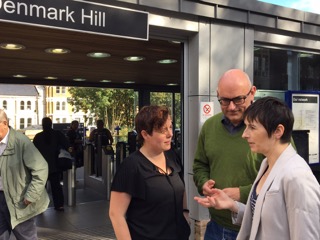I’ve just obtained a copy of a study undertaken by Network Rail at Denmark Hill station over two days in July 2015, approximately two weeks before the start of state school holidays. So the many local private schools would have already started their summer school holidays. Video cameras captured the tops of all stairs to the platforms and also the gateline. Counts were completed for the AM (07:00 – 10:00) and PM (16:00 – 19:00) peaks and were classified by person type (i.e. person with large luggage, bicycle etc).
Counts were provided in 5 minute intervals and showed that flows were slightly higher in the AM on Wednesday at 10,700 (10,400 on Tuesday) and in the PM on Tuesday at 9,200 (8,800 on Wednesday). On both days the AM peak was considerably busier than the PM peak.
The AM flows were very balanced with similar numbers of passengers entering and exiting the station (52/48 in favour of exits).
The Access for All footbridge is used by approximately 30% of passengers in the AM peak, the remaining 70% using the original overbridge. So the decision by Southwark Planners to block widening the original footbridge is causing much of the congestion problem. This resulted in a new ticket office entrance which already isn’t wide enough exacerbated by stairs to reach it
Platform 4 (towards Bromley) only accounts for 7% of flows in the AM peak but 26% of flows in the PM peak.
The PM peak has a more tidal flow with station entries making up 60% of gateline movements. The Access for All overbridge is used by 32% of passengers in the PM peak, slightly more (2%) than in the AM peak.
We need to find out when the extra Windsor Walk station entrance can happen. The congestions for passengers feels decidedly dangerous.
Annual footfall at Denmark Hill station
The latest ORR footfall figure for Denmark Hill station is shown below. As mentioned on Friday, some of the difference between the 2015-16 and 2014-15 figure “is due to changes to the methodology” associated with the London Travelcard. The leap in passenger numbers in 2013-14 reflected the first full year of operation of the south-western branch of the London Overground network.
